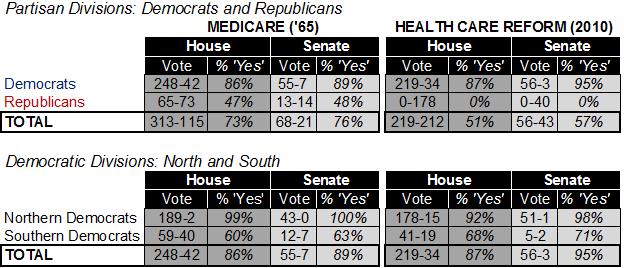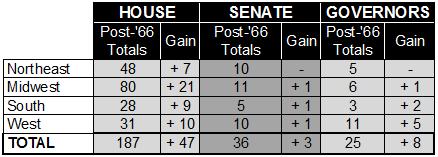Midterms Past: The '66 Parallel
A Commentary by Rhodes Cook
For months now, this election has been compared to that of 1994, when Republicans scored huge gains and won both houses of Congress. It is a decent model. But given the recent passage of health care reform – something that did not happen in ’94 – this might be a good occasion to look at another midterm election for instruction, that of 1966.
As now, it was a time of bold presidential initiatives buttressed by large Democratic majorities on both sides of Capitol Hill. A plethora of liberal domestic legislation was enacted, featuring the primary health care reform of the age, Medicare (government-run medical care for the elderly), which was passed in 1965.
But the mid-1960s was also a period of growing unrest – with an economy going off the tracks, an overseas war that was escalating, and a president whose approval rating was sinking after starting around 70% at the time of his inauguration.
Republicans scored large gains across the country in the midterm election of 1966. They were not enough to win control of either house of Congress. But the GOP comeback did restore the Republican “brand” – badly tarnished by Arizona Sen. Barry Goldwater’s landslide loss in 1964. The ’66 election also brought forth a whole new generation of Republican leaders and began turning the tenor of national debate from a liberal to conservative bent, where it has essentially remained to this day.
Few pundits then thought the Republican Party could make such a quick turnaround. The GOP was routed at all levels in 1964 – in large part due to Goldwater’s full-throated conservatism and a large sympathy vote cast in honor of Democratic President John F. Kennedy, who had been assassinated in November 1963.
Kennedy’s successor, Lyndon B. Johnson, swept 44 states and more than 60% of the popular vote in 1964. His Democratic ticket-mates won more than two-thirds of the seats in the House and Senate, and nearly two-thirds of the nation’s governorships.
The 89th Congress opened the following January with President Johnson and Democratic congressional leaders ready for action. The Johnson agenda was so ambitious in its intent to eradicate poverty, increase minority rights, and extend health care that it was termed the “Great Society.” What followed was a flurry of domestic legislation not seen since the early days of Franklin D. Roosevelt’s New Deal.
Republicans complained about a “rubber-stamp Congress” but were powerless to stop the legislative onslaught. Far from putting up a united front in opposition to Democratic measures, Republicans in the House and Senate broke about evenly pro and con on issues such as Medicare. By the fall of 1965, Johnson was able to hail “this session of Congress (as) the greatest in American history.”
Chart 1. Congressional Votes on Medicare (1965) and Health Care Reform (2010)
Passage of Medicare in 1965 was one of the major achievements of President Lyndon B. Johnson, just as enactment of health care reform this March has been the high point thus far of Barack Obama’s presidency. The latter measure passed both houses of Congress without a single Republican vote, a contrast with the bipartisan support for Medicare that enabled it to win approval by decisive margins in both the House and the Senate. Meanwhile, Democratic legislators in 1965 and 2010 gave both landmark pieces of legislation similarly strong support.
Note: The House vote for 2010 is based on the motion to concur in the Senate amendments to the Patient Protection and Affordable Care Act, which passed March 21. The 2010 Senate vote is based on passage of the Health Care and Education Reconciliation Act of 2010 (as amended) on March 25. The two independent senators who caucus with the Democratic Party are included in the 2010 Democratic Senate vote totals. The South is comprised of the 11 states of the Confederacy plus Kentucky and Oklahoma.
Sources: 1965 CQ Almanac; www.thomas.gov for 2010 votes.
But as the calendar flipped to 1966, the Democrats’ seemingly perfect political world began to implode. The expanding war in Vietnam started to enter the public consciousness, the once-booming economy showed signs of inflation, and racial rioting broke out in some of the nation’s major urban centers.
In short order, terms such as “guns and butter” and “credibility gap” entered the political vocabulary, while LBJ’s approval rating began to go into free fall. It had stood around 60% at the beginning of 1966, but by that fall had dropped to below 45%. Johnson himself was not a major player in the midterm campaigning. A scheduled election-eve campaign swing on behalf of Democratic candidates was cancelled for health reasons, with the president undergoing surgery on his throat and abdomen shortly after the November voting.
To the GOP’s benefit, the Republican National Committee was headed by former Ohio party boss Ray Bliss, who emphasized the nuts and bolts of organization over ideological litmus tests. Republicans of all stripes were encouraged to run in 1966, and both the conservative and liberal wings of the party enjoyed considerable success – from Ronald Reagan’s initial gubernatorial victory in California to Gov. Nelson Rockefeller’s reelection to a third term in New York.
In many instances, Republicans regained terrain they had lost in the ’64 landslide. Roughly one-third of the 71 Democratic House freshmen elected that year were ousted in 1966. Virtually all of them had voted for Medicare and gave broad support to other presidential initiatives. With their departure, the curtain essentially came down on Johnson’s “Great Society.”
Altogether, Republicans added 47 seats in the House, three seats in the Senate and eight governorships in 1966. That brought the party’s totals to roughly where they are today:
Republicans posted significant gains in all parts of the country in ’66. Nearly half of their House pick ups were in the Midwest, the widely recognized birthplace of the GOP. More than half of Republican gubernatorial gains were in the West, while the party continued to be a competitive force across the Northeast. Meanwhile, for the first time, Republicans showed signs of becoming a truly national party by expanding the beachheads the party had already made across the South. The GOP inroads made clear that the region was no longer solidly Democratic but one that could embrace conservative Republicanism.
From the GOP’s expanding gubernatorial ranks came some of the leading candidates for the Republican presidential nomination in 1968 – Rockefeller, Reagan and Michigan’s George Romney, in particular. But no politician had used the midterm election year more effectively than former Vice President Richard Nixon, who with his young aide-de camp, Pat Buchanan, took to the “rubber chicken circuit” on behalf of Republican candidates across the country. It was a comeback for Nixon that mirrored his party’s, as he earned valuable chits in 1966 that two years later would be turned into convention delegates as he mounted his second, finally successful, try for the presidency.
As for Johnson, he was reflective in the wake of his party’s defeat in 1966. A large number of his recommendations had been acted upon in the previous few years, he noted. And while the Democratic congressional losses were a bit more severe than he had anticipated, he thought that they could prove beneficial to the party in Congress. Johnson indicated that when he was Democratic Senate majority leader, he found there was greater unity when the party’s majority was smaller.
The president also found some benefits for the nation as a whole from the midterm results in the form of a healthier two-party system. “The American people have a way of balancing things,” he concluded. “… It will bring out the best that is in both parties.”
Chart 2. The Republicans’ 1966 Comeback: A National Revival
Republicans rebounded quickly from their 1964 electoral debacle, when they were left with less than one-third of the seats in both the House and the Senate and barely one-third of the nation’s governorships. Two years later the GOP made dramatic gains in both houses of Congress and the states, reaching numbers in the House, Senate and governorships similar to what Republicans have today. Unlike the modern Southern-centric GOP, however, the congressional wing of the Republican Party that emerged from the 1966 election had its strongest base in the party’s historic home, the Midwest, while the West provided the GOP with its largest number of governorships. Back then, Republicans were only beginning to make headway in the South.
Note: Following are the states that belong to each region for the purposes of this study:
NORTHEAST (12) – Connecticut, Delaware, Maine, Maryland, Massachusetts, New Hampshire, New Jersey, New York, Pennsylvania, Rhode Island, Vermont, West Virginia.
MIDWEST (12) – Illinois, Indiana, Iowa, Kansas, Michigan, Minnesota, Missouri, Nebraska, North Dakota, Ohio, South Dakota, Wisconsin.
SOUTH (13) – Alabama, Arkansas, Florida, Georgia, Kentucky, Louisiana, Mississippi, North Carolina, Oklahoma, South Carolina, Tennessee, Texas, Virginia.
WEST (13) – Alaska, Arizona, California, Colorado, Idaho, Hawaii, Montana, Nevada, New Mexico, Oregon, Utah, Washington, Wyoming.
Source: 1966 CQ Almanac.
Rhodes Cook is a senior columnist at the Center for Politics at the University of Virginia
See Other Commentary by Rhodes Cook
See Other Political Commentary
Views expressed in this column are those of the author, not those of Rasmussen Reports.
Rasmussen Reports is a media company specializing in the collection, publication and distribution of public opinion information.
We conduct public opinion polls on a variety of topics to inform our audience on events in the news and other topics of interest. To ensure editorial control and independence, we pay for the polls ourselves and generate revenue through the sale of subscriptions, sponsorships, and advertising. Nightly polling on politics, business and lifestyle topics provides the content to update the Rasmussen Reports web site many times each day. If it's in the news, it's in our polls. Additionally, the data drives a daily update newsletter and various media outlets across the country.
Some information, including the Rasmussen Reports daily Presidential Tracking Poll and commentaries are available for free to the general public. Subscriptions are available for $4.95 a month or 34.95 a year that provide subscribers with exclusive access to more than 20 stories per week on upcoming elections, consumer confidence, and issues that affect us all. For those who are really into the numbers, Platinum Members can review demographic crosstabs and a full history of our data.
To learn more about our methodology, click here.






